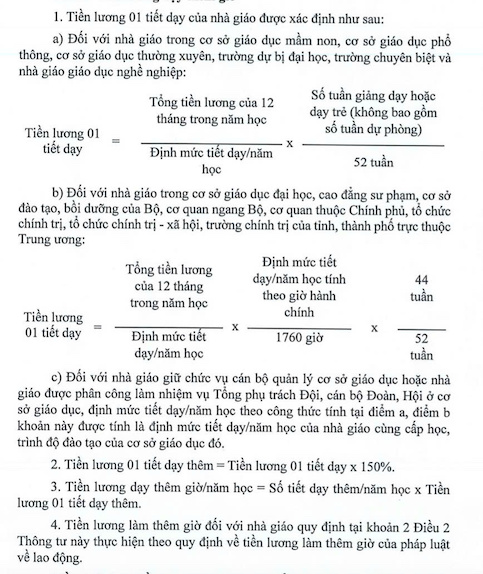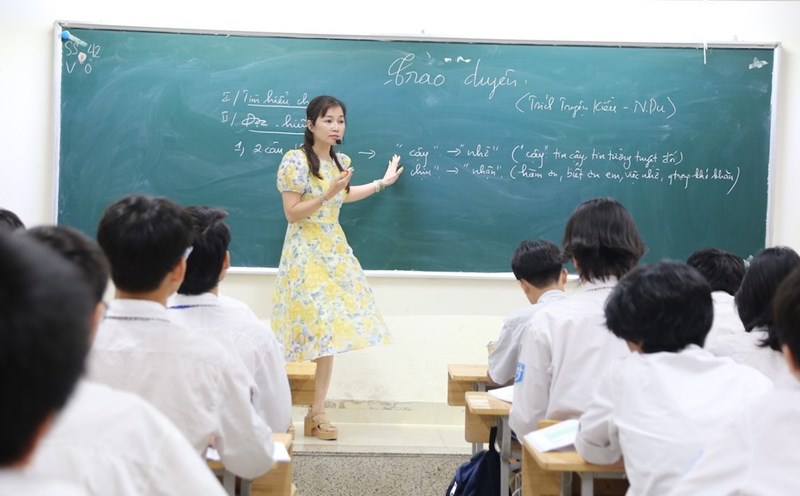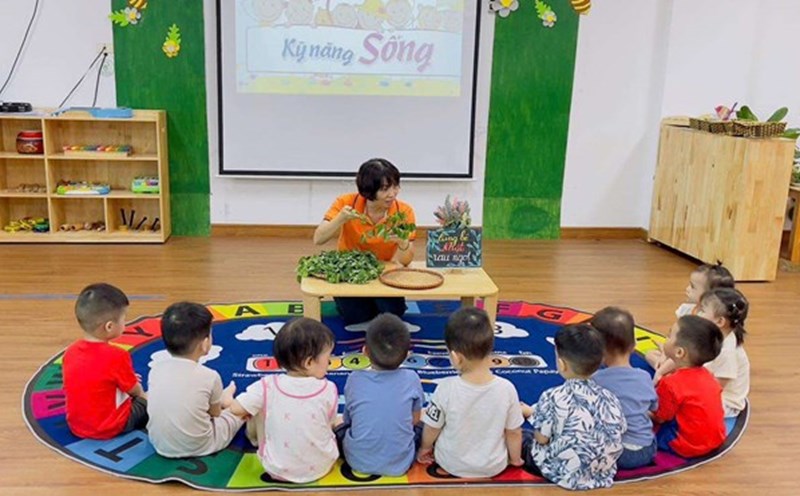The Ministry of Education and Training (MOET) issued Circular No. 21/2025/TT-BGDDT regulating the regime of paying overtime wages to teachers in public educational institutions (Circular No. 21). Here are the new points in the circular:
Adjusting conditions for payment of overtime teaching wages
The new Circular removes the regulation on conditions for payment of overtime wages in Clause 6, Article 3 of Joint Circular No. 7.
Clause 6, Article 3 of Joint Circular No. 07 stipulates: Only pay for overtime teaching salaries in units or subjects with a shortage of teachers approved by competent authorities. Units or departments that do not lack teachers are only paid for overtime teaching wages when there are teachers on sick leave, maternity leave according to the provisions of the Law on Social Insurance or going to study, receive training, participate in inspection teams, inspect and participate in other work (hereinafter referred to as going to work on other tasks) assigned or transferred by competent authorities to arrange other teachers to teach instead".
In fact, the number of teachers approved by competent authorities is almost lower than the number of teachers according to the standards prescribed by the Ministry of Education and Training - the level prescribed to ensure the implementation of educational programs on the basis of meeting the working regime of teachers. In addition, with the characteristics of teaching by subject, although the total number of teachers is equal to the standard, when calculating by subject, there is still a situation of excess subjects and shortage of teachers; for subjects lacking, teachers have to teach extra hours.
Preschool teachers work 6 hours a day, but in reality, due to the nature of their profession and the requirements of young parents, they often have to pick up their children early and drop them off late (except for some cases where they have to work directly at school from 6:30 to 6:00, that is, the actual working time can be up to 9 - 10 hours).
Thus, although educational institutions have enough assigned teachers, in reality, there is still a situation where teachers have to teach more than the prescribed teaching period quota without being paid for overtime teaching salaries.
To ensure that teachers who teach extra hours are paid for their allowances, ensure fairness in assigning tasks between teachers in the same educational institution and the payment of overtime wages in accordance with the requirements of implementing the education program, Circular No. 21 stipulates a number of binding conditions.
The Circular stipulates that the total number of extra teaching periods in a school year of all teachers must not be higher than the maximum total of extra teaching periods in a school year of the educational institution that the educational institution is allowed to pay. In which, the total number of extra teaching periods paid by educational institutions is the total number of periods that need to be implemented for all tasks minus the total number of standard periods of all teachers present in practice.
At the same time, it is stipulated that the total number of extra teaching periods in a school year for each teacher must not exceed 200 periods.
Adjusting the total number of extra teaching periods in a school year for teachers who are paid overtime salary
According to Circular No. 21, the total number of extra teaching periods in a school year for each teacher must not exceed 200 periods. This replaces the regulation that the total number of extra teaching periods to be paid for overtime pay in a school year does not exceed the number of overtime hours as prescribed by law as in the previous Joint Circular No. 07.
This regulation ensures compliance with the characteristics of teachers' professional activities and ensures that teachers do not have to work overloaded, have time to rest to rest and restore labor, in accordance with the provisions of the Labor Code.
The salary calculation formula is adjusted to suit the current
Adjust the salary of 01 extra teaching period for lecturers, managers of educational institutions working in higher education institutions, pedagogical colleges, training and fostering institutions of ministries, ministerial-level agencies, agencies under the Government, political organizations, socio-political schools of provinces and centrally run cities to ensure the regulation of the working regime of lecturers according to Circular No. 20/2020/TT-BGDDT and Circular No. 36/2020/TT-BGDDT.

Supplementing regulations on the responsibility to pay overtime wages for seconded and inter-school teachers
According to Circular No. 21, the salary for teaching extra hours for seconded teachers is paid by the educational institution where the seconded teachers are. The overtime teaching salary of teachers teaching in inter-schools is paid by the educational institution where teachers teach in inter-schools.
In case a teacher is sent to teach at 03 or more educational institutions at the same time (including the educational institution where the teacher works), the salary for teaching extra hours of the teacher will be paid by the educational institutions where the teacher teaches at the same institution according to the actual number of teaching periods of teachers in these educational institutions.
Supplementing regulations on the time of payment of overtime salary for teachers
The new Circular stipulates that the payment of overtime wages for teachers will be made after the end of the school year. However, in the case of teachers retiring, quitting jobs, being transferred, or transferred, the payment of overtime teaching wages will be made at the time of the decision to retire, quit jobs, be transferred, or transferred by the competent authority.
Supplementing regulations on payment of overtime wages for teachers who have worked for less than a school year
If teachers have less than 1 year of teaching time, they will receive overtime salary corresponding to actual working time. Circular No. 21 also specifically guides the formula for calculating salary for 01 teaching period and the total number of teaching periods paid for overtime salary for teachers who have worked for less than 1 school year as a basis for calculating overtime salary for 01 school year to ensure teachers' rights.
Supplementing separate regulations for higher education institutions, colleges, training and development institutions of ministries, ministerial-level agencies, agencies under the Government, provincial and centrally run political schools, and centrally run cities
Pursuant to the provisions of Circular No. 21, educational institutions regulate the working regime of teachers, relevant legal provisions and actual conditions to regulate the payment of overtime teaching salaries for teachers under their management authority to ensure autonomy for educational institutions.
Circular No. 21 takes effect from the date of promulgation. Educational institutions shall base on the regulations to develop separate regulations of the unit to ensure that the new Circular is implemented from the beginning of the 2025-2026 school year.
In particular, determining the total maximum number of extra teaching periods in a school year for which educational institutions are paid overtime pay, making an estimate of overtime pay and sending it to competent authorities for approval and funding allocation. At the same time, it will be the basis for assigning and arranging the tasks of teachers appropriately, ensuring the rights of teachers, in accordance with the funding source for paying overtime teaching salaries.









